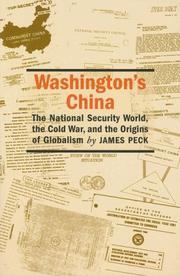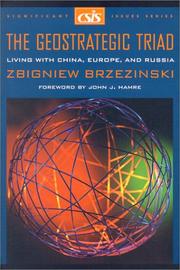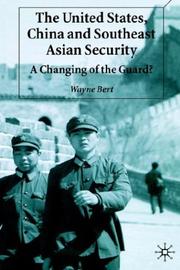| Listing 1 - 10 of 54 | << page >> |
Sort by
|
Book
ISBN: 9781784715724 1784715735 1784715727 Year: 2016 Publisher: Cheltenham, UK ; Northampton, MA : Edward Elgar Publishing,
Abstract | Keywords | Export | Availability | Bookmark
 Loading...
Loading...Choose an application
- Reference Manager
- EndNote
- RefWorks (Direct export to RefWorks)
This handbook addresses the key questions surrounding US-China relations: what are the historical and contemporary contexts that underpin this complex relationship? How has the strategic rivalry between the two evolved? What are the key flashpoints in their relationship? What are the key security issues between the two powers? The international contributors explore the historical, political, economic, military, and international and regional spheres of the US-China relationship. The topics they discuss include human rights, Chinese public perception of the United States, US-China strategic rivalry, China's defence build-up and cyberwar.

ISBN: 0231068050 0231068042 1283008963 9786613008961 0231521723 9780231521727 9780231150767 0231150768 9780231150774 0231150776 Year: 2010 Publisher: New York Columbia University Press
Abstract | Keywords | Export | Availability | Bookmark
 Loading...
Loading...Choose an application
- Reference Manager
- EndNote
- RefWorks (Direct export to RefWorks)
America's Response to China has long been the standard resource for a succinct, historically grounded assessment of an increasingly complicated relationship. Written by one of America's leading diplomatic historians, this book analyzes the concerns and conceptions that have shaped U.S.-China policy and examines their far-reaching outcomes. Warren I. Cohen begins with the mercantile interests of the newly independent American colonies and discusses subsequent events up to the Tiananmen Square massacre and the policies of George H. W. Bush and Bill Clinton. For this fifth edition, Cohen adds
United States --- China --- Etats-Unis --- Chine --- Foreign relations --- Relations extérieures --- Relations extérieures --- United States - Foreign relations - China. --- China - Foreign relations - United States.

ISBN: 1558495371 1558495363 9781558495 9781558495371 9781558495364 Year: 2006 Publisher: Amherst: University of Massachusetts press,
Abstract | Keywords | Export | Availability | Bookmark
 Loading...
Loading...Choose an application
- Reference Manager
- EndNote
- RefWorks (Direct export to RefWorks)
Book
ISBN: 9781442219694 9781442219700 9781442219717 1442219718 1442219696 144221970X Year: 2013 Publisher: Lanham : Rowman & Littlefield Publishers,
Abstract | Keywords | Export | Availability | Bookmark
 Loading...
Loading...Choose an application
- Reference Manager
- EndNote
- RefWorks (Direct export to RefWorks)
United States --- China --- Foreign relations --- Relations internationales --- Chine --- États-Unis --- Relations --- United States - Foreign relations - China --- China - Foreign relations - United States

ISSN: 07367136 ISBN: 089206384X 9780892063840 Year: 2001 Volume: 23, no. 1 Publisher: Washington Center for strategic and international studies
Abstract | Keywords | Export | Availability | Bookmark
 Loading...
Loading...Choose an application
- Reference Manager
- EndNote
- RefWorks (Direct export to RefWorks)
United States --- China --- Europe --- Russia (Federation) --- Foreign relations --- 876 Veiligheidspolitiek --- United States - Foreign relations - China --- China - Foreign relations - United States --- United States - Foreign relations - Europe --- Europe - Foreign relations - United States --- United States - Foreign relations - Russia (Federation) --- Russia (Federation) - Foreign relations - United States --- United States - Foreign relations - 1989 --- -876 Veiligheidspolitiek --- -United States - Foreign relations - China --- -China

ISBN: 0804724539 9780804724531 Year: 1995 Publisher: Stanford, Calif. Stanford University Press
Abstract | Keywords | Export | Availability | Bookmark
 Loading...
Loading...Choose an application
- Reference Manager
- EndNote
- RefWorks (Direct export to RefWorks)
Book
ISBN: 9780691159515 0691159513 Year: 2014 Publisher: Princeton Oxford Princeton University Press
Abstract | Keywords | Export | Availability | Bookmark
 Loading...
Loading...Choose an application
- Reference Manager
- EndNote
- RefWorks (Direct export to RefWorks)
"After forty years of largely cooperative Sino-U.S. relations, policymakers, politicians, and pundits on both sides of the Pacific see growing tensions between the United States and China. Some go so far as to predict a future of conflict, driven by the inevitable rivalry between an established and a rising power, and urge their leaders to prepare now for a future showdown. Others argue that the deep economic interdependence between the two countries and the many areas of shared interests will lead to more collaborative relations in the coming decades.In this book, James Steinberg and Michael O'Hanlon stake out a third, less deterministic position. They argue that there are powerful domestic and international factors, especially in the military and security realms, that could well push the bilateral relationship toward an arms race and confrontation, even though both sides will be far worse off if such a future comes to pass. They contend that this pessimistic scenario can be confidently avoided only if China and the United States adopt deliberate policies designed to address the security dilemma that besets the relationship between a rising and an established power. The authors propose a set of policy proposals to achieve a sustainable, relatively cooperative relationship between the two nations, based on the concept of providing mutual strategic reassurance in such key areas as nuclear weapons and missile defense, space and cyber operations, and military basing and deployments, while also demonstrating strategic resolve to protect vital national interests, including, in the case of the United States, its commitments to regional allies"--
United States --- China --- Etats-Unis --- Chine --- Foreign relations --- Relations extérieures --- History --- Relations extérieures --- 21st century --- Political science --- International relations --- Arms control --- United States - Foreign relations - China - History - 21st century --- China - Foreign relations - United States - History - 21st century

ISBN: 0333995651 9780333995655 Year: 2003 Publisher: New York : Palgrave Macmillan,
Abstract | Keywords | Export | Availability | Bookmark
 Loading...
Loading...Choose an application
- Reference Manager
- EndNote
- RefWorks (Direct export to RefWorks)
National security --- Sécurité nationale --- United States --- China --- Etats-Unis --- Chine --- Foreign relations --- Relations extérieures --- Sécurité nationale --- Relations extérieures --- National security - Southeast Asia --- United States - Foreign relations - China --- China - Foreign relations - United States
Book
ISBN: 9780262028998 0262028999 Year: 2015 Publisher: Cambridge, Mass. MIT Press
Abstract | Keywords | Export | Availability | Bookmark
 Loading...
Loading...Choose an application
- Reference Manager
- EndNote
- RefWorks (Direct export to RefWorks)
World War, 1914-1918 --- Causes --- United States --- China --- Foreign relations --- PolemologyUnited States --- Polemology --- Polemologie --- Verenigde Staten van Amerika --- World War, 1914-1918 - Causes --- United States - Foreign relations - China --- China - Foreign relations - United States --- United States of America
Book
ISBN: 9780231176545 9780231546904 0231176546 0231546904 Year: 2018 Publisher: New York, N.Y. Columbia University Press
Abstract | Keywords | Export | Availability | Bookmark
 Loading...
Loading...Choose an application
- Reference Manager
- EndNote
- RefWorks (Direct export to RefWorks)
Since the collapse of the Soviet Union, the international system has been unipolar, centered on the United States. But the rise of China foreshadows a change in the distribution of power. Øystein Tunsjø shows that the international system is moving toward a U.S.-China standoff, bringing us back to bipolarity—a system in which no third power can challenge the top two. The Return of Bipolarity in World Politics surveys the new era of superpowers to argue that the combined effects of the narrowing power gap between China and the United States and the widening power gap between China and any third-ranking power portend a new bipolar system that will differ in crucial ways from that of the last century. Tunsjø expands Kenneth N. Waltz’s structural-realist theory to examine the new bipolarity within the context of geopolitics, which he calls “geostructural realism.” He considers how a new bipolar system will affect balancing and stability in U.S.-China relations, predicting that the new bipolarity will not be as prone to arms races as the previous era’s; that the risk of limited war between the two superpowers is likely to be higher in the coming bipolarity, especially since the two powers are primarily rivals at sea rather than on land; and that the superpowers are likely to be preoccupied with rivalry and conflict in East Asia instead of globally. Tunsjø presents a major challenge to how international relations understands superpowers in the twenty-first century.
S09/0610 --- China: Foreign relations and world politics--China and USA: since 1949 --- United States --- China --- Foreign relations --- Bipolarity (International relations) --- International relations. Foreign policy --- United States - Foreign relations - China. --- China - Foreign relations - United States. --- United States of America
| Listing 1 - 10 of 54 | << page >> |
Sort by
|

 Search
Search Feedback
Feedback About UniCat
About UniCat  Help
Help News
News